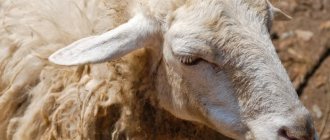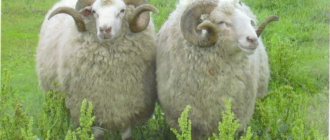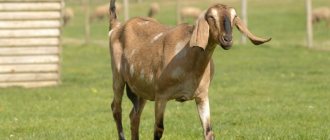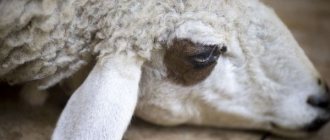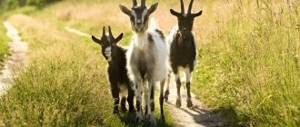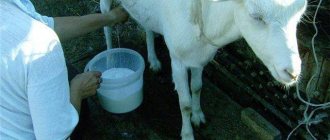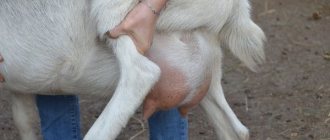Almost everyone knows who a lamb is, because that’s what a baby sheep is called. But why it is customary to call it that and how the meek, little sheep differs from other children of domestic animals, what features it has, is worth considering in more detail.
Lamb's mother is a sheep, father is a ram
Sheep are artiodactyl mammals, members of the bovid family. Since ancient times, young sheep have been domesticated by humans in order to obtain soft, fluffy wool and lamb, which is characterized by high nutritional properties. Milk, cheese, fat, and sheepskin are obtained from sheep.
A ram is a stubborn male, a sheep is a female ram. Females are slightly larger in size than males, their hair is thicker and denser. The male is endowed with strong horns. After crossing, a small lamb appears after 5 months. Sexual characteristics are not visible in newborn lambs immediately after birth. Only after 2-3 months does the owner determine the sex of the individual: it is a young sheep or a ram.
Young females that have reached sexual maturity but have not lambed are called lambs.
The lamb's mother is a sheep, and her father is a ram. Their small offspring are lambs. As you can see, everything is quite simple.
Origin of names
They call a baby sheep and ram that for a reason. The appearance of the name of the animal in Rus' dates back to the 10th century. It is a derivative of the ancient Slavic “aries” and means “ram”.
In ancient Rome, these animals were called "agnus" in Latin. The child of a ram had religious significance and was called a “lamb.” This is where the terms “lamb - child of God” and “sacrificial lamb” came from. The word "lamb" has the root "yagn" and a suffix that together mean "little sheep."
Animals were often used as sacrifices and symbolized the birth of hope and complacency. With the adoption of Christianity in Rus', the baby sheep and ram eventually ceased to be used as a sacrifice. The term “lamb” was used less and less in everyday life. In religion, it has been preserved, but does not have such practical significance as before. In fairy tales, the little sheep is a symbol of goodness, innocence, and meekness.
Sheep are artiodactyl mammals, representatives of the bovid family.
Today, the young of these curly-haired domestic animals are no longer called lambs. They are called lambs.
There are several options for the correct name for a little sheep. People come up with different terms. But you need to know that the correct names of all members of the family depend on the age of the animal.
A lamb is a baby lamb under one year of age. He is still quite weak and defenseless, so he requires special care. A young sheep is bright. Already at the age of one and a half years, Yarka turns from a female lamb into a real mother.
Sheep, rams and their young
We should start talking about domestic animals and their young with an animal that was one of the first to be domesticated by humans. We are talking about sheep and rams. One little sheep could save an entire family. These creatures gave people not only milk and meat, but also warm wool. It should be noted that a young sheep could be used not only as a source of wool, meat and milk, but also as a religious symbol.
It's time to figure out what a baby sheep and ram is called. Sheep and ram are domestic artiodactyl animals that belong to the bovid family. As you might guess, a mature female of this animal is called a sheep, and a male is called a ram. City dwellers ignorant of agriculture often think that these are different animals. Accordingly, various non-existent animals appear, for example, a female ram or a male sheep.
There are also a number of strange versions about what the baby of these animals is called. Often, as an answer to the question, what is the name of a baby sheep and ram, you can hear different options: little sheep, little sheep, little lamb, etc. Among the strangest names we can also distinguish: ram (for a male) and little sheep (for a female).
Description and lifestyle of the scoter duck
All these names do not correspond to the accepted name in Russian for the young animals of these animals. It is important to remember that the offspring of a ram and the baby ewe will have the same name. The only correct name for their baby is lamb.
Language experts believe that the origin of the word for little lamb is related to religious rituals. For many peoples, the little sheep was associated with the birth of hope and freedom. Often a small sheep was used as a sacrificial animal.
Thus, the word lamb has a very ancient history. According to scientists, the Russian name comes from the Latin agnus, from which the Old Slavic lamb first appeared.
Today, the little sheep no longer has the same sacred meaning that ancient people gave it. The lamb is considered only as a young domestic animal.
Now we know what a baby sheep is called, and if necessary, we can explain why it was called that. From now on, the question of who the lamb’s mother is will no longer be perplexing.
It is worth noting that there is a special designation for sheep that have left the most tender age, but have not yet reached marriageable age. Thus, a young sheep, already an adult, but not yet capable of procreation, has a special name. You can often hear the strange word yarka in the speech of farmers. This is what a young sheep that has not yet produced offspring is called.
What is the correct name for a baby sheep?
You can often find the following names :
- sheep;
- baby sheep;
- sheep;
- lamb;
- little sheep;
- sheep, etc.
But there is also a universal term that can be used to call children of both sexes.
sheep is correctly called a lamb .
It is extremely difficult to trace the origin of this word to the end. There is one main version. There is a theory that the term “lamb” comes from the Latin word “agnus.” This is what these animals were called in Ancient Rome many centuries ago. From this word comes the name “lamb,” which is also sometimes used to call lambs. But this term is already considered obsolete , it is surrounded by excessive religiosity and is often associated with the ritual of sacrifice.
We also recommend reading:
Gissar breed of sheep, large rams: characteristics Rams and sheep - what are the differences and what they are like How to build a sheepfold for sheep with your own hands Growing and breeding Romanov breed sheep
Therefore, in the modern world the term “lamb” has been completely replaced by the more melodic “lamb”.
Pigs and their offspring
Pigs, like sheep, were domesticated by humans at the very beginning of human history. These animals belong to the order Artiodactyls. Pigs provide humans with meat, lard, skin and stubble. This is why they are bred on farms.
Funny animal echidna: description, lifestyle in nature
A male pig is called a boar, a boar, a hog, a female is a pig, a sow. Baby pigs are called piglets. We need to figure out why the parents and the baby have such different names.
As already mentioned, pigs were domesticated by humans in ancient times. Back then, people preferred to use different words to refer to male and female animals.
The common word pig is cognate with the German Schwein, the English swine and the Latin suinus. Apparently, in the ancient Indo-European language it meant the female of this animal, bearing offspring. So the male form would be the pig. The word comes from the Indo-European sus - pig.
Pigs, like sheep, were domesticated by humans at the very beginning of human history.
But in ancient times the boar was called differently. In the Proto-Slavic language, linguists restored the form porse for it, in Latin - porsus. The ancient Slavs called a male pig poros. This is where the word pig comes from. As is easy to see, it is formed using the suffix -enok, which means a small creature.
Initially, only male babies were called piglets. Gradually the name spread to all children of the pig.
By the way, the process of the birth of cubs is called farrowing, and a pregnant pig is called pregnant, that is, having been under litter. So even our modern language preserves the ancient names of animals.
Baby animals
Let's start with pets. They catch the eye of children more often, and therefore arouse greater interest.
Let's look at what a baby sheep is called. Many people living in cities do not even realize that sheep and ram are one type of animal, only female and male. Their baby is not called a ewe or lamb, but a lamb.
This is interesting! The word lamb comes from the Latin agnus. In the Old Church Slavonic language, a baby sheep and ram sounds like a lamb. The name of the animal contained the root “yagn”. Later, the suffix “enok” was added to it, which denotes a reduced form. Hence the name - lamb.
Pig
Pigs are one of the first animals to be domesticated by humans. They belong to the order Artiodactyls. They supply people with meat and lard. The female pig is called a sow or pig, and the male is called a boar or boar. But their baby is called not a pig or a hog, but a piglet.
This is interesting! The Slavs called a male pig a poros. The addition of the suffix “enok”, again, means a reduced form. Hence the name - piglet.
By the way, the birth of piglets is called farrowing, and a pregnant pig is called gestation.
Cow
Cows have been tamed by humans since ancient times. They give people meat and milk. The male cow is called a bull, and the baby is called a calf. Another example of the fact that children and parents have different roots.
Experts still cannot figure out where the word calf came from; there are only guesses. One of them is that among the ancient Slavs this word meant “born”, but cows bear their offspring for 9 months.
Turkey
America is the homeland of turkeys. But in recent centuries, this bird has been grown in European countries.
This is interesting! Few people know that turkeys are named after their homeland. Previously, America was called the West Indies, so the name of the birds is translated as Indian rooster.
In this case, parents and their children have the same root. A female turkey is called a gobbler or turkey, and her baby is called a poult.
Rabbit
Another domestic animal is the rabbit. The female is called a rabbit, the male is called a rabbit, and their baby is called a bunny.
Rabbits are raised for meat, hides and fur. The Angora breed of animals has valuable fur; beautiful and expensive fur coats are made from it.
Scientists also test drugs on rabbits before releasing them for sale. Not long ago, dwarf breeds of rabbits were bred; now they are kept in apartments instead of hamsters and guinea pigs.
Unlike previous animals, goats are not so often raised by people, but there are entire farms with them. The fact is that in addition to meat and fatty milk, these animals provide people with skin and wool.
The female of these animals is a goat, the male is a goat, and their baby is a kid. The baby’s name still contains the same “diminutive” suffix “enok”.
Many people confuse kids with lambs. This is a big misconception because we are talking about two different species of animals.
Horses
Horses were domesticated more than 7,000 years ago. During this time, people developed many breeds of these animals, from miniature ponies to huge draft horses and horses.
A female horse is called a mare, a male is called a stallion or horse, and their baby is called a foal. If we are talking about two or more babies, then the word foals is used.
Speaking in general about this type of animal, two names are applied to them: horses and steeds.
Ducks can be wild or domestic. They belong to the order of birds and are valued for the taste of their meat. The female of these birds is called a duck, mallard, the male is called a drake, and their baby is called a duckling. If we are talking about two or more chicks, then the word ducklings is used.
We looked at domestic animals, but there are many more wild and tropical animals, as well as fish and birds, that are of interest to children and adults.
Very often children ask: what is the name of a baby zebra or giraffe? But not every adult will immediately answer this question.
Cow, bull and calf
The cow, like the sheep and pig, was domesticated in ancient times. This animal gives people milk and meat. Her skin is also used.
A male cow is called a bull. And the baby cow is a calf. The names bull and heifer are also acceptable. They indicate the different sexes of the young.
It is worth understanding why again parents and their young have names that come from different roots.
The word “cow” itself comes from the same stem as the Latin cornu, meaning horn. Thus, it is a horned animal.
The origin of the word “calf” is still controversial among experts. The most common version says that in ancient times the word meant “worn out.”
Goat, goat and kid
Another domestic animal often found on farms is the goat. These artiodactyls provide humans with more than just milk from which cheese is made. Depending on the breed, in addition to milk and meat, they also produce skins, wool and fluff.
I must say that there are significantly fewer problems with naming a child a goat. The male of this animal is a goat, the female is a goat. And even the smallest children, thanks to fairy tales and cartoons, know that a baby goat is a kid. As you can see, the already familiar suffix is again involved in the formation of the cub’s name.
Sometimes non-specialists call baby goats lambs. This is absolutely false. As is already clear, each domestic animal has its own name for its children: a sheep has a lamb, a goat has a kid.
By the way, a goat can give birth to 1 to 5 kids. So the famous tale about the wolf somewhat exaggerates the fertility of this animal.
General characteristics of the animal
These are powerful and beautiful animals with a molded and muscular body, strong legs and a small head. The body length of adult goats can reach 180 cm, and the height at the withers is about a meter.
Alpine ibex
The dimensions of females are more modest: body length 100-130 cm, height 70-80 cm. The weight of an adult varies between 40-150 kg depending on the type of animal and its gender.
Male and female mountain goats have horns. In goats they are small, no more than 20 cm in length, straight or slightly curved back. In goats, the horny processes can reach more than a meter in length.
The horn decoration can have a curved or straight shape, the horns can curl into a spiral or have pronounced ring thickenings.
They grow throughout the animal's life and never change. The size of the “crown” can even determine the approximate age of the animal.
Wild mountain goat
Male and female mountain goats differ from each other in appearance:
- males are larger than females (sometimes 2 times);
- Goats have smaller horns;
- goats have odorous glands that emit a specific musky odor;
- males have a beard up to 30 cm long;
- Sometimes a goat has a “mane” - elongated, coarse hair on the neck and chest.
The fur of artiodactyls is dense and thick, consisting of coarse hairs, with a thick, developed undercoat.
In some representatives of the genus it is long, can reach the ground, with a lot of fluff.
Goats molt in spring and fall. In winter they are covered with down, which helps them survive severe frosts. Common colors: white, gray, brown, brown, black.
Be sure to read:
Is it necessary to boil goat milk, what diseases of goats are dangerous for humans, medical advice
The hooves of mountain goats are small, with an exceptionally hard surface that is resistant to abrasion from rocks.
Pets and their babies (video)
Breeding domestic animals requires not only theoretical but also practical knowledge. It is necessary to understand how to act with a newborn lamb, what to feed and in what conditions the future offspring should be kept. Many people often ask the question of what is the name of a baby sheep, young pig, goat, cow and turkey. For answers, you should turn to history and the opinions of professional farmers.
Breeding domestic animals requires not only theoretical but also practical knowledge
What is the name of a baby sheep? How is he different from his parents? A sheep is a domestic artiodactyl animal that belongs to the bovid family. The mammal was domesticated in ancient times; it was the main source of wool and meat. A small sheep can feed an entire family. In the modern world, sheep wool is used to make many products necessary for human life.
Farmers in the narrow sense by sheep mean females, and males are called rams. Females are smaller than males in size and have thicker, denser fur. Many beginners often ask the question of what a baby sheep and ram is called. Inexperienced farmers often give the wrong answer. Some people come up with the most unusual names - “sheepling”, “sheepling”, “baby sheep”. However, all these assumptions are wrong. The origin of the word is associated with religious rites that were carried out in ancient times. In the annals of many tribes, a baby sheep and ram was associated with the birth of hope and freedom; the animal was used as a sacrifice. Now the little sheep that is born has nothing to do with ancient records; it is considered a continuation of the population.
A sheep is a domestic artiodactyl animal that belongs to the bovid family
A small ewe or young lamb that has just been born is a newborn lamb. The origin of this word is related to the Latin “agnus”, which translated into Russian means “lamb”. Additionally, the word "lamb" has a root and suffix that together translate to "little sheep." It is also worth considering that scientists named females capable of procreation in a special way. A young sheep that has not reached puberty is called "bright", a designation often used by professional farmers. But a small sheep that is not yet capable of procreating and does not have thick wool is also called a lamb. The maturation cycle of the female is usually monitored.
A small ewe or young lamb that has just been born is a newborn lamb.
A baby of a ram and a ewe is born weighing a little more than 4 kg, the main difference is its mobility and activity. After giving birth, the mother of the lamb should be kept warm; in the first hours, the owner is required to provide water and monitor the well-being of the animal. Otherwise, the young sheep may get sick, lose appetite and stop producing milk.
The most popular breed is the Romanovskaya. A small sheep of this breed feels comfortable in the central and northern regions of the country. Raising these pets is a very profitable business; their wool is valued by buyers.
Names of young domestic animals and birds
What are the names of baby animals that help humans? On farms you can see a large number of mammals and birds, from which meat and wool are obtained. Among them are a young sheep, a cow, a turkey, a goat, a pig and their offspring. Animal breeding is usually carried out by professionals who understand the intricacies of this work. The most important thing is to be able to see the differences between breeds, determine the sex of future cubs and organize favorable conditions for the preservation of the family. Animal children are usually born weak and need help from others.
The pig is the second most popular domestic animal belonging to the artiodactyl order. There are 8 species of animals, which include the wild sheep, the ancestor of the pig. These domestic animals are characterized by a long muzzle and compact build. The pig has very large canines, which are pointed and well developed. The hairline mainly consists of bristles. A baby pig is called a piglet.
A goat is a necessary and important domestic animal for a rural farmer. She is the main source of tasty milk, warm wool, strong skin and valuable meat. A baby goat is usually born weak and requires human help. A goat, like a female ram, produces a small number of babies in her litter. The kids are born weak, their mother teaches them to walk.
The turkey is a large domestic bird that is directly related to the wild turkey. Birds are very sensitive to the environment and cannot stay in cold and damp rooms. It is also worth considering that the animals have a very uncooperative character, so no more than 30 females and 5 males should be placed in one room. A baby turkey has its own name - turkey poult (possibly chick). The incubation period is 28 days.
Lifestyle
Goats live in herds, from a dozen individuals to several hundred. The number of animals in a herd may increase during seasonal migration to pastures.
Be sure to read:
Do-it-yourself goat's rue: requirements for a barn, pen, feeders, walls and floor
Adult goats live in small groups or alone. They join females in the fall, at the time of mating.
Animals have unique abilities to move along almost sheer cliffs.
Their habitat extends to an altitude of up to 5000 m above sea level.
There are photos and videos of mountain goats galloping along barely noticeable ledges on a steep wall.
Interesting. Sometimes animals overestimate their strength. Fleeing from predators, goats climb into places from which they cannot descend. They can stand for many hours on a tiny patch of horizontal surface, and then, exhausted, fall into the abyss.
The diet of mountain goats includes all available mountain vegetation: grasses, foliage and bark of shrubs and trees, mosses and lichens. Goats do not disdain mushrooms and berries.
Animals graze in the mornings or at night, going down to places rich in vegetation to do this. During the day they prefer to hide in areas that are difficult to reach for predators and people, high in the mountains.
Interesting. Like other ruminant herbivores, mountain goats constantly need salt. They can find salt marshes by smell, sometimes traveling up to 20 km a day to do this.
Artiodactyls mate in the fall - at the beginning of winter.
Siberian mountain goat
Males enter into battle with rivals to obtain females. Despite the apparent brutality of the battle, animals are rarely seriously injured. A weak individual quickly assesses the opponent’s power and concedes.
After 5 months, in May–June, the female gives birth to 1-2 kids, which within an hour after birth stand on their feet and are ready to follow their mother.
For the first couple of weeks, until the kids get stronger, the mother hides with them in a secluded cave or in a hard-to-reach crevice. Only with stronger babies does she go out to the rest of the group of goats.
Females of one group (or family) are friendly towards all cubs and are equally ready to protect them from predators.
Be sure to read:
When does a goat begin to give first milk, how to milk a goat correctly and how many times after lambing
Kids grow quickly, and by the time their first winter arrives, they are almost the same size as adults. But they reach sexual maturity only after a year.
Natural enemies of mountain goats: leopards, snow leopards, lynxes, wolves. Sometimes birds of prey (golden eagles) manage to drag away a kid.
Goats are not easy prey, as they are cautious, mistrustful and strong.
Goats have acute hearing and vision. Even the most powerful predator will not dare to attack an adult healthy individual. Weak and sick animals become prey.
Man has long hunted goats, valuing their tender meat and strong skin. The gorgeous antlers of a seasoned male are a valuable hunting trophy.
Goats die due to avalanches and severe frosts.


